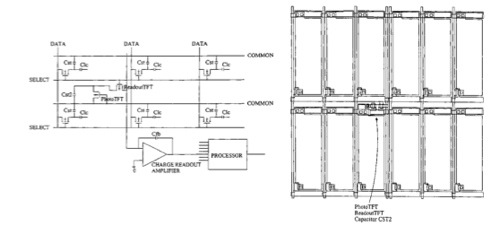Apple has been granted a patent (number 7,830,461) by the US Patent & Trademark Office for a light sensitive display. It relates to touch sensitive displays that could eventually be used with iOS devices.
Here's Apple's background and summary of the invention: "Touch sensitive screens ("touch screens") are devices that typically mount over a display such as a cathode ray tube. With a touch screen, a user can select from options displayed on the display's viewing surface by touching the surface adjacent to the desired option, or, in some designs, touching the option directly. Common techniques employed in these devices for detecting the location of a touch include mechanical buttons, crossed beams of infrared light, acoustic surface waves, capacitance sensing, and resistive materials.
"For example, Kasday, U.S. Pat. No. 4,484,179 discloses an optically-based touch screen comprising a flexible clear membrane supported above a glass screen whose edges are fitted with photodiodes. When the membrane is flexed into contact with the screen by a touch, light which previously would have passed through the membrane and glass screen is trapped between the screen surfaces by total internal reflection. This trapped light travels to the edge of the glass screen where it is detected by the photodiodes which produce a corresponding output signal. The touch position is determined by coordinating the position of the CRT raster beam with the timing of the output signals from the several photodiodes. The optically-based touch screen increases the expense of the display, and increases the complexity of the display.
"Denlinger, U.S. Pat. No. 4,782,328 on the other hand, relies on reflection of ambient light from the actual touch source, such as a finger or pointer, into a pair of photosensors mounted at corners of the touch screen. By measuring the intensity of the reflected light received by each photosensor, a computer calculates the location of the touch source with reference to the screen. The inclusion of the photosensors and associated computer increases the expense of the display, and increases the complexity of the display.
"May, U.S. Pat. No. 5,105,186, discloses a liquid crystal touch screen that includes an upper glass sheet and a lower glass sheet separated by spacers. Sandwiched between the glass sheets is a thin layer of liquid crystal material. The inner surface of each piece of glass is coated with a transparent, conductive layer of metal oxide. Affixed to the outer surface of the upper glass sheet is an upper polarizer which comprises the display's viewing surface. Affixed to the outer surface of glass sheet is a lower polarizer. Forming the back surface of the liquid crystal display is a transflector adjacent to the lower polarizer.
"A transflector transmits some of the light striking its surface and reflects some light. Adjacent to transflector is a light detecting array of light dependent resistors whose resistance varies with the intensity of light detected. The resistance increases as the light intensity decreases, such as occurs when a shadow is cast on the viewing surface. The light detecting array detect a change in the light transmitted through the transflector caused by a touching of viewing surface. Similar to touch sensitive structures affixed to the front of the liquid crystal stack, the light sensitive material affixed to the rear of the liquid crystal stack similarly pose potential problems limiting contrast of the display, increasing the expense of the display, and increasing the complexity of the display.
"Touch screens that have a transparent surface which mounts between the user and the display's viewing surface have several drawbacks. For example, the transparent surface, and other layers between the liquid crystal material and the transparent surface may result in multiple reflections which decreases the display's contrast and produces glare. Moreover, adding an additional touch panel to the display increases the manufacturing expense of the display and increases the complexity of the display. Also, the incorporation of the touch screen reduces the overall manufacturing yield of the display.
"Accordingly, what is desired is a touch screen that does not significantly decrease the contrast ratio, does not significantly increase the glare, does not significantly increase the expense of the display, and does not significantly increase the complexity of the display."
The inventors are Adiel Abileah and Willem den Boer.
Apple was also awarded design patents for a docking station (patent number D626,940) and dock insert (patent number D626,941).














